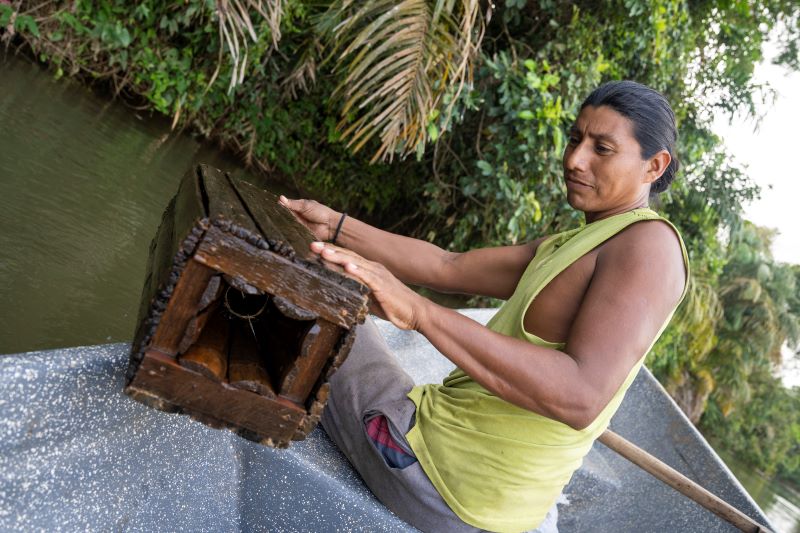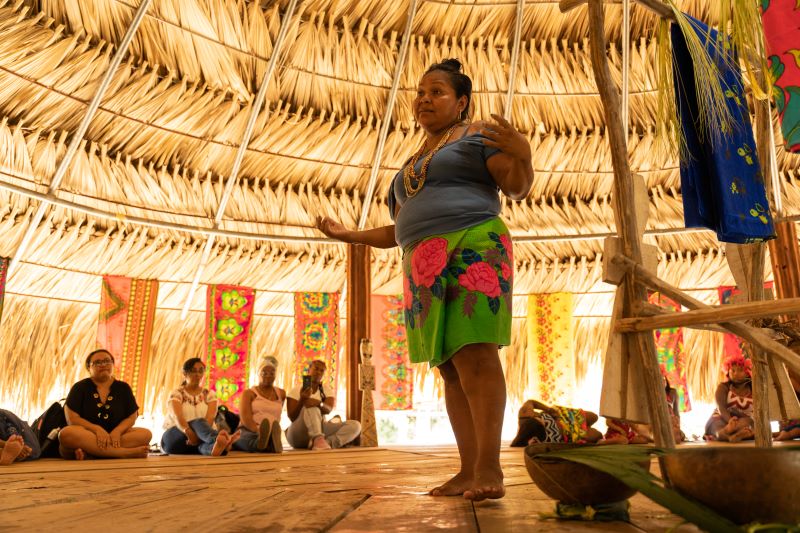Tired of waiting for donor dollars for climate and nature protection to trickle down, Indigenous rights groups are creating new funds to do things differently
For over a decade, Indigenous and local communities have demanded a bigger share of international funding to protect nature and the climate, as well as easier access to that money. But progress has been limited, with only 1-2 percent of such finance reaching them directly, reports show.
Now frustrated Indigenous rights groups are trying a new tactic to speed up change: creating their own funds in a push to boost the flow of money to frontline communities and shift away from what some see as an outdated colonial-style model driven by donors in the Global North.
Since 2020 – and especially last year – more than half a dozen new Indigenous-led funds have sprung up, largely in forest-rich Brazil but also in developing countries from Indonesia to Mexico.
Many are still in a start-up phase, but a few have already begun pushing money to frontline communities. They include the Mesoamerican Territorial Fund (MTF), which invested $1.3 million in 32 projects – from chocolate production to tourism and protecting traditional knowledge – in communities from Mexico to Panama last year.
“We are aiming not only to make the funds reach the real guardians of the forest and the real guardians of mitigating and adapting to climate change, but also to support sustainability, democracy and good governance of all these territories,” said María Pía Hernández, a lawyer and regional manager for the MTF.
World Bank climate funding greens African hotels while fishermen sink
Multilateral funds can take years to approve projects and often struggle to funnel big pots of nature and climate finance into the smaller-scale projects communities need, Indigenous leaders said.
The new funds aim to fill the gap by gathering large amounts of money, distributing it nimbly and leap-frogging the barriers faced by forest communities in dealing with traditional funds, such as onerous paperwork.
“We aim to improve not just the condition of the territories and people who live there but also promote global climatic justice,” Hernández said on the sidelines of last week’s Skoll World Forum, a gathering of social innovators.
Bypassing the giants
As the World Bank and International Monetary Fund hold their Spring Meetings in Washington this week, focused in part on reshaping lending for climate action, Indigenous communities are already rethinking how to better access the resources they need to protect nature and the climate – and to ensure those on the frontline benefit from changes such as new clean energy infrastructure.
Along the way, they are setting up new rules and structures in line with their own traditions and beliefs, after years of chafing against constraints imposed by big donors, some of them former colonial powers.
In Canada, for instance, many Indigenous governing bodies now run their own renewable energy utilities, providing a fifth of Canada’s renewables, said Joan Carling, executive director of Indigenous Peoples Rights International.
“If we transform the business-as-usual and create the enabling environment and conditions to put Indigenous people at the centre of this, then we can have a truly just, equitable renewable energy for all,” she said.
A new dashboard released last week by the Rights and Resources Initiative and the Rainforest Foundation Norway shows climate finance for indigenous and local communities rose between 2020 and 2023 to about $517 million per year, a 36 percent increase over the previous four years.
That increase comes after governments and charitable donors promised $1.7 billion back in 2021 to Indigenous and local communities by 2025 for their role in protecting land and forests, which are considered key to protecting both the climate and biodiversity.
Yet with much new funding still moving through big international environment organisations and other intermediary agencies, rather than directly to communities, “there is no evidence yet indicating a systematic change in funding modalities,” the groups noted in a report.
Connecting communities with cash
Solange Bandiaky-Badji, coordinator of the Rights and Resources Initiative, said improving direct access to funding is the key issue. At least $10 billion in finance for Indigenous and local communities will be needed to meet a global pledge to protect at least 30 percent of the planet’s land and oceans by 2030, she added.
Indigenous-led funds believe they can be pivotal to achieving that ramp-up.
Shandia, established by the Global Alliance of Territorial Communities uniting 35 million people from 24 countries, is still in a start-up phase but aims to serve as a conduit for much larger-scale finance to Indigenous and other frontline groups.
“Millions of dollars are moving in the world. We want to connect claims on the ground to those millions,” said Juan Carlos Jintiach, a Shuar indigenous leader from Ecuador and the alliance’s executive secretary, who was shortlisted for the Nobel Peace Prize last year for his work on behalf of Indigenous communities.
Indonesia’s main Indigenous alliance similarly in 2023 helped establish the Nusantara Fund, while in Brazil a range of Indigenous-led vehicles, including the Podáali Indigenous Amazonian Fund, were launched last year.
Guardians of the forest – and finance?
Anthony Bebbington, who runs the Ford Foundation’s international natural resources and change change programmes, said the last few years had seen the emergence of substantial new funds, with the potential to grow, that are challenging the traditional ways donors have worked.
“Funds are saying to us, ‘If you trust us to be guardians of the forest – a role for which we are often harassed and sometimes killed – then there is no justification for you to also not trust us to be guardians of the finance’,” he told an event on the sidelines of the Skoll World Forum.
In projects backed by the Mesoamerican Territorial Fund, for instance, indicators of success are changing from a simple focus on hectares of forest replanted to include things like whether more water is flowing through key rivers, said Hernández, whose fund so far gets 80 percent of its support from philanthropies.

An Indigenous Ramas man lifts a crayfish trap in the Rio Indio river, San Juan de Nicaragua, Nicaragua on February 16, 2022.(Photo: Reuters/Antoine Boureau/Hans Lucas)
The MTF also actively seeks out and helps prepare applications from Indigenous and local communities that could benefit from its support rather than just accepting grant proposals, as traditional donors often do.
David Rothschild, senior director of partnerships for Nia Tero, a US non-profit that works with Indigenous groups, said avoiding heavy paperwork was key to enabling the new funds take off.
“What they don’t want is to become another entity in the system operating in a colonial way. How do they not fall into the same patterns that have been destructive, while still reporting to donors?” he asked.
Hernández said new ways of working are developing, if sometimes too slowly. “We are not asking for blank cheques,” she emphasised. “But we deserve a little bit of consideration.”
(Reporting by Laurie Goering; editing by Megan Rowling)
Read More

